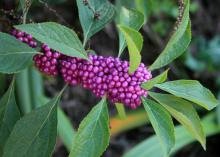Information Possibly Outdated
The information presented on this page was originally released on September 3, 2018. It may not be outdated, but please search our site for more current information. If you plan to quote or reference this information in a publication, please check with the Extension specialist or author before proceeding.
Native fall beautyberry belongs in the landscape
I’ve noticed a common characteristic among us gardeners. As we go through the year, our favorite plants in the landscape and garden seem to change from week to week.
To other gardeners, this makes sense, as our landscape plants go through their life cycles. And, boy, am I glad that the plants are on different growth and development cycles. It would really be boring if they were in sync.
One plant that always brings a smile to my face and lots of question when I post it on social media is American beautyberry. This plant just seems to pop up randomly along roadsides, at the edges of wooded areas and in people’s yards.
American beautyberry, known botanically as Callicarpa americana, is a native plant species found all across Mississippi. It has a wide distribution range east of the Mississippi River in the mid-Atlantic and Gulf Coast regions.
Despite its native status, American beautyberry is quite at home and, in my opinion, desirable in the home landscape.
Its flowers are rather inconspicuous unless you’re taking a really close look. I think the lavender-pink flowers are quite attractive. But what draws the most attention is the production of bright magenta-purple berries in tight clusters all up and down the arching stems of the straight species. Some plants have such heavy berry production that it seems like the leaves are growing out of the clusters.
You are not limited to only purple berries. The Alba selections have white berries, and I really like the Welch’s Pink selection that was first found in west Texas. These have pastel-pink berries that bleach out into the fall.
It is worth noting that crape myrtle bark scale has been found on American beautyberries. It seems this destructive, nonnative insect pest to our beloved crape myrtles is using the native beautyberry to gain a foothold. It may also be using other species of Callicarpa grown in the Southeast as forage stock. We’ll have to keep an eye on this development.
I’ve recently read where some folks are calling American beautyberry an invasive species, but that is far from the truth. It is true that it reseeds and birds move the seed around, but since it is native to the Southeast, it shouldn’t be considered invasive.
Beautyberry has a loose and open habit. One plant can be attractive, but a grouping of two or three creates a full cluster. The plants cross pollinate, which helps ensure the fullest fruit production. Beautyberry tolerates dry soil conditions and part shade, but full sun provides for the healthiest plants and best fruit presentation. Be sure to maintain consistent soil moisture.
There are a few different species of beautyberry that have differences in mature size and berry arrangement. All are generally referred to as beautyberry in garden centers and nurseries. In my opinion, what the plants are called doesn’t matter, so long as you have one or two in your landscape.
Regardless of the variety, beautyberry berries will persist into the fall and winter until the birds pick the branches clean.




